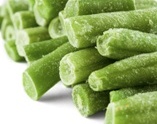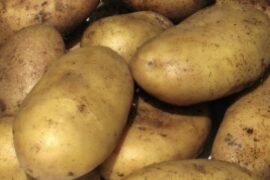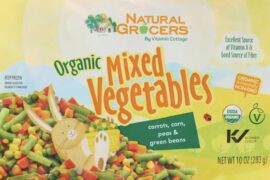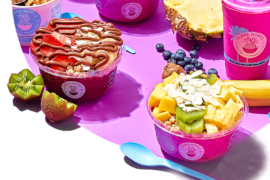With recent surveys showing that frozen vegetable sales are relatively flat and purchases of canned vegetables are falling, the European Association of Fruit and Vegetable Processors (PROFEL) knows that it has to do something to spark renewed interest in the categories among retail market shoppers. New strategies for making this happen will no doubt be high on the agenda at the organization’s general assembly meeting June 26-27 in Helsinki, Finland.
A new “Green Gospel” (as in an A-Z Testament of the Benefits of Frozen Greens – from asparagus, beans and broccoli, to cabbage, celery, courgettes, cucumbers, leeks, peas, peppers, spinach, zucchini and more) must be preached. So too must the IQF advantages of orange carrots, yellow corn, purple eggplant, and diced red tomatoes be sermonized.
Among the “evangelists” tasked with spreading the word are Herwig Dejonghe, chief operations officer of Greenyard Foods, and Pieter Kruithof, managing director of Oerlemans Foods, who respectively are chairman and vice chairman of Brussels-headquartered PROFEL’s Frozen Vegetables Product Group.
Editors of FrozenFoodsBiz.com recently met with Dejonghe and members of the Greenyard Foods’ frozen division, Pinguin Foods, in Westrozebeke, Belgium, to get an update on the processed vegetable market in Europe. As always when in the company of Pinguin professionals, the mood was thoroughly upbeat regarding the frozen food business.
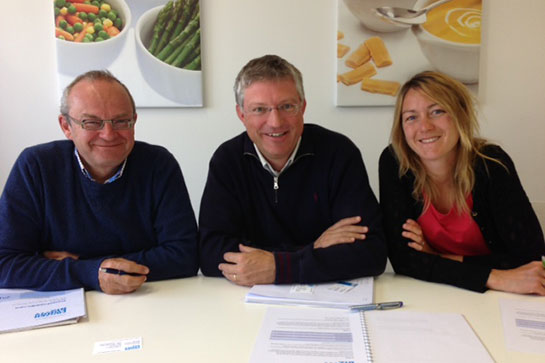 Talking about ways and means to better promote processed vegetable and fruit products with FrozenFoodsBiz.com editors are (left to right): Herwig Dejonghe, chief operations officer of Greenyard Foods and chairman of PROFEL’s Frozen Vegetables Product Group; Steven Vanhaverbeke, commercial director of the Pinguin division of Greenyard Foods; and Hannelore Dejonghe, Pinguin’s marketing manager.
Talking about ways and means to better promote processed vegetable and fruit products with FrozenFoodsBiz.com editors are (left to right): Herwig Dejonghe, chief operations officer of Greenyard Foods and chairman of PROFEL’s Frozen Vegetables Product Group; Steven Vanhaverbeke, commercial director of the Pinguin division of Greenyard Foods; and Hannelore Dejonghe, Pinguin’s marketing manager.
“IQF vegetable sales and consumption continue to grow in the foodservice sector, where operators not only understand and appreciate the value and advantages of frozen products, but are convinced that vegetables frozen at their peak of ripeness within hours after harvest are much fresher than most so-called ‘fresh’ vegetables available on the market,” said Dejonghe. “This is because foodservice buyers know that fresh vegetables have generally been in the distribution channel for many days before finally being consumed.”
“Our challenge is getting this message across to shoppers in retail stores and to reach consumers who believe, without evidence, that non-processed vegetables are somehow better for them,” stated Steven Vanhaverbeke, commercial director of Pinguin, which ranks as Europe’s second largest producer and marketer of frozen vegetable products.
The truth is, as confirmed by a PROFEL-commissioned study published back in 2006, that both frozen and so-called ‘fresh’ vegetables deliver nutrients to consumers in a comparable way, though levels vary by variety. Furthermore, vitamins are retained in frozen vegetables for over a year, while nutritional losses in fresh vegetables only one week after harvest exceed losses incurred during processing.
Interestingly, according to an earlier VLAG study, the beta-carotene content in carrots is little affected by blanching, which is required to inactivate enzymes. And though industrial washing of certain vegetables results in a slight reduction of vitamin C potency, with most varieties there is little or no loss.
Another study, carried out by the Center for Food Innovation at Sheffeld Hallum University in the United Kingdom, found that 77% of vitamin C content in green beans is lost during seven days of unrefrigerated storage. Additionally, there is evidence that cooked frozen green peas contain higher levels of beta-carotene – which converts into vitamin A in the human body – than are present in fresh peas.
“Nutritive values are virtually undisturbed with quick freezing, and in the process the appearance, color, texture and flavor of vegetables and fruits are fully preserved without the use of additives of any sort,” said Dejonghe.
As the chairman of PROFEL’s Frozen Vegetables Product Group, Dejonghe is spending a good deal of time lobbying political authorities, as well as communicating with allied trade associations, consumer groups and the press about the importance of daily consuming multiple servings of vegetables and fruits of all kinds – especially those that are farmed and packed in the European Union.
“In Europe, governments are subsidizing the distribution of bananas, none of which are produced in the EU, to children. We should be using taxpayers’ money to feed them regionally-sourced cooked spinach instead,” said Dejonghe.
The PROFEL chairman suggested that a major campaign ought to be launched to promote the advantages of cooked vegetables, both frozen and canned, among consumers taking meals at home. Such a drive could lend support or build upon an established European Program for the Generic Promotion of Processed Vegetables, which is a coordinated public relations effort in France, Belgium and the Netherlands aimed at households with children as well as health professionals and the media.
“Many of the top ten vegetables sold in supermarkets and food stores in Europe, such as carrots, are often consumed raw. Yet to benefit most from the vitamins and nutrients of vegetables, they should be cooked,” insisted Dejonghe. “Canned tomatoes, for example, are better than fresh tomatoes precisely because they have been cooked.”
Heat actually enhances certain nutrients, such as lycopene (the bright red carotene and carotenoid pigment and psychochemical), transforming them into forms that are easier for the human body to absorb. Indeed, cooking tomatoes increases their lycopene content by three to four times. Lycopene, which has been linked to a reduced risk of heart attack and cancer, is typically low in raw-food diets.
“Steamed vegetables are also higher in antioxidants, and cooking can increase the beta-carotene in carrots. The anticancer compound indole actually forms when heat is present, and is higher in steamed cabbage, broccoli and cauliflower than in raw vegetables,” points out sports nutritionist Angela Brady.
Kale and spinach show an uptick in certain nutrients when cooked, according to the USDA Nutrient Data Laboratory. It reports that cooked kale has 2.5 grams of protein, 0.52 grams of fat and 2.6 grams of fiber. Raw kale has similar protein and fat content, but only half the fiber. Other nutrients that increase in cooked kale include vitamins A, K and beta-carotene.
Spinach’s protein content rises from 0.86 grams in one cup of raw spinach to 5.4 grams per cooked cup. Minerals that are more concentrated in cooked spinach include calcium, iron, magnesium and potassium. Vitamins that increase in cooked spinach include vitamin C, vitamin A, folate, beta-carotene and lutein.
Dejonghe told FrozenFoodsBiz.com that efforts must be stepped up to educate school children in particular about the merits of frozen cooked vegetables.
“In France today, the younger generation has less confidence in frozen vegetables than do their parents. This needs to be turned around,” he said.
Part of the reason that youngsters are not giving frozen foods their proper due may have to do with the fact that their mothers and fathers are slow-freezing leftovers at home for future consumption, which generally produces a less than appetizing result. In the UK, producers of chilled ready meals (many of whom, incidentally, make no apologies about using previously frozen components in their recipes), spell out on packaging that unused portions may be frozen and eaten later.
Now this is simply offering unwise advice to consumers, since it is common knowledge among food scientists and nutritionists (who should be in the employ of chilled food manufacturers, or at least serve as their outsourced advisors) that both animal and vegetable cells, when frozen slowly at temperatures not far below the freezing point of water, as is the case in most home freezers, swell and rupture. The result, after thawing, is that the product is mushy and leaks fluids and juice. However, when food is frozen quickly at -20° to -30°F, and held at about 0°F until thawed, the cell walls and nutritive value remain totally intact.
“Our job in educating consumers is never-ending,” said Dejonghe. “One of things I want to accomplish over the next two years (which is the term of his PROFEL chairmanship) is moving vegetables closer to the base of the Food Pyramid’s dietary guidelines. In Mediterranean countries vegetables and fruits rank second in importance only to water, ahead of bread and other grain-based products. This is how it should be across Europe.”
Also regarded as a matter of priority is the need to spotlight the important role that processed vegetables play in agriculture sustainability and the reduction of food waste.
“Save Food initiatives have moved to the forefront among political issue in Europe today, much as decreasing carbon footprints was yesterday,” said Dejonghe. “Well, certainly the foundation of the frozen and canned vegetable business is built on reducing food waste by extending shelf life.”
Indeed. While it is estimated that more than 90 million tons of food waste are generated every year in the EU, and according to the United Nations’ Food and Agriculture Organization (FAO) up to 1.3 billion tons of food annually ends up in the bin worldwide, the processed vegetable and fruit industries contribute very little to the pile. This is because, unlike so-called ‘fresh’ product, there are virtually no post-production storage losses in the distribution chain due to deterioration or spoilage. What’s more, packaging such as reclosable polybags and boxes allows consumers to easily take just as much as they need from the pack and return the rest to the freezer for safekeeping.
“We have a lot to offer, from portion-controlled healthy and nutritious fruits and vegetables to high-level food safety, waste reduction and much more,” said Dejonghe. “Our industry is a leader in less input/more output of sustainable, additive-free products. We just have to work smarter and more creatively to better promote the many positive values and benefits for consumers.” – JMS

